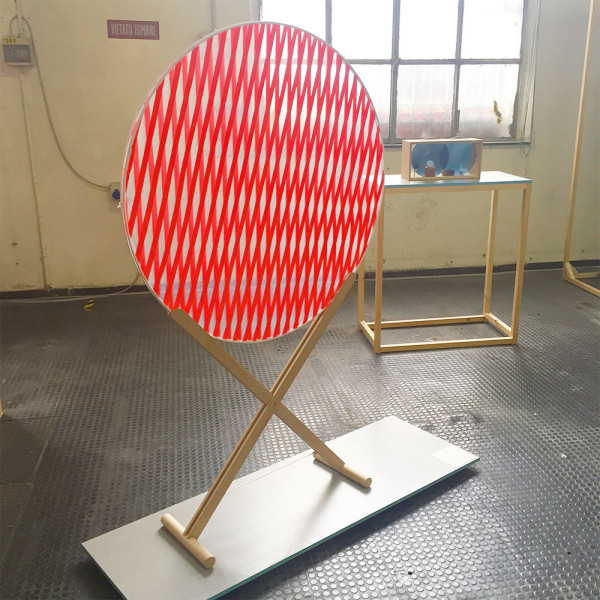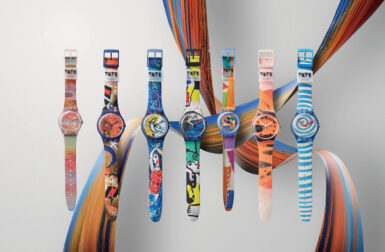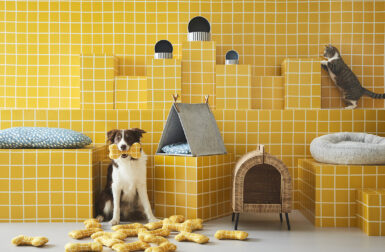Ventura Lambrate is my favorite design district in Milan – always packed with student and graduate work, it’s where the new ideas are. Projects are often still in concept or prototype stage, and rarely commercially available (yet), but that’s what makes it exciting. This year, even the unexpected downpour on what’s largely an outdoor event, failed to dampen my spirits – although a very British cup of tea did replace the usual Italian gelato! The first thing to catch my eye was Michiel van der Kley’s Project Egg. It is constructed, to his plans, from 4,760 individual pieces 3D printed by people all over the world. “Project Egg is about 3D printing, the power of sharing and co-creating, about new ways to create and collaborate,” said the designer.
Humus was an installation by Centre D’Enseignement Professionnel de Vevey ceramics students demonstrating different throwing techniques – I like its utterly organic aesthetic.
Proof that the geometric trend is still alive and kicking, the ISO / Breakfast Set by Marta Ferrer comprises a glass, two plates, two bowls and a tray. “Their forms take into account the purest geometry, including creating various compositions according to the position of the various elements. Besides, a graphic application on the pieces generates a playful and decorative appearance contributing consequently to the set unity,” said the designer.
The Kaleido Screen by Japanese industrial design student Junichiro Oshima provided a welcome hit of color. Two striped circles can be twisted in opposite directions to create different patterns and make the screen more or less opaque – the screen’s height can be adjusted by moving the legs. “Kaleido is a partition to make a boundary and divide a space by creating a beautiful surface using groups of lines,” said the designer.
Ripple wall and table organizers by Hiroyuki Ikeuchi use the strength of curved paper to create structures that don’t require glue or screws. “When a paper is sandwiched between two matching surfaces, it traces the sandwiching surfaces and extends their shape into the space,” said the designers. “Now if the sandwiching surfaces are curved, then paper is also shaped into a curved surface and creates a strong structure. Ripple is a series of solids that not only act as paper weight, but also are using this phenomenon, being pairs of matching solids, to turn paper sheets into stiff surfaces functioning as trays, vases or little shelves.”
In response to what he sees as too much plastic and unnecessary ingredients, Lund University student Olaf Janson has developed the Toothpaster – everything you need to make your own natural toothpaste. “There are many toothpaste brands on the market,” said the designer. “They all try to complicate the shit out of each other by promising more protection, more whitening, and anti-aging. They pack these promises in plastic and back them up with long lists of ingredients, chemicals we never heard of. The sad truth is that many of these ingredients are redundant and some can even be harmful. The fact of the matter is that it is easy to make toothpaste and that everyone could do it for themselves with few and natural ingredients. The toothpaste mixing movement has already started, sharing recipes with each other. In the Toothpaster, I have made a collection of containers and tools to help this movement on its way.”
Fellow Lund student Oskar Olsson presented the Burks system, a reusable food packaging system, designed to eliminate disposable packaging. “The Burks are part of a system designed to eradicate the food packaging industry because it is actually pretty bad,” said the designer. “With its 200 kg of waste per person and seagull fatalities due to plastic bag ingestion, the environmental impact is enormous. With the Burks system, where grocery products are sold in bulk, a future without the above mentioned issues could be possible. Seagulls may be noisy, but air and water are pretty nice.”
Norwegian Presence in Milan was one of the highlights of Ventura Lambrate – a collaboration between Klubben (The Norwegian Designers’ Union), Norwegian Crafts, and Norwegian Icons, the exhibition showcased the best of Norwegian craft. I loved Treet by Morten & Jonas, a playful side table comprising three differently-shaped and colored solid oak trays on top of a slender frame.
In the same space, the Mikkel blankets by Kristine Five Melvær – currently prototypes by Norwegian manufacturer Røros Tweed – were inspired by the Bauhaus movement and the Norwegian wool tradition and combine Kristine’s industrial design training with her graphic design background. They come in four colors and were particularly appealing on the coldest day of the week!
Martyna Barbara Golik created a design for each of the five senses – this was “sour” expressed in blanket form, the result of experimentation with liquid rubber, hand tufting and upholstery techniques.
These acoustic wall tiles are made from recycled paper pulp by Dear Human, a Canadian creative studio founded by Jasna Sokolovic and Noel O’Connell in 2011. “Other than their decorative potential, they have great sound absorbing qualities and are easy to install,” said the designers. “We use 100% post-consumer paper, collected from local businesses.”
There were some lovely pastel colors at Milan this year, epitomized by this lamp and bowls by Università IUAV di Venezia graduate Enrico Zanolla.
And finally, a fantastic installation from Marcia Nolte, Stijn van der Vleuten and Bob Waardenburg – the three people behind Dutch collective We Make Carpets – who have been making carpets from simple, everyday things that you might find in your kitchen drawer for five years. From pasta to clothes pegs, from party hats to plastic cups, anything can become part of intricate patterns that they build on their hands and knees from the inside out.


































